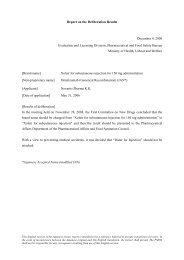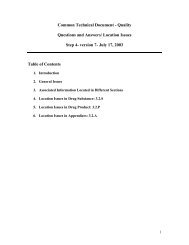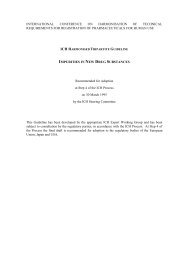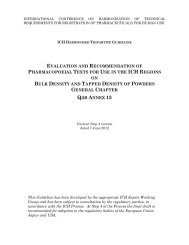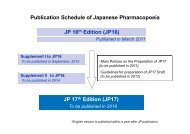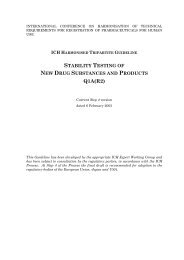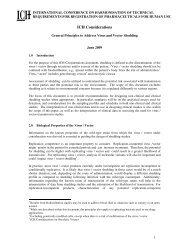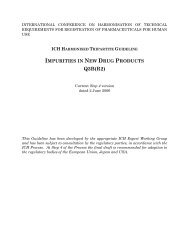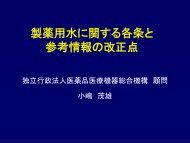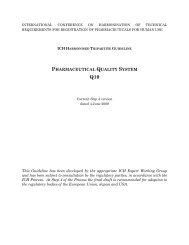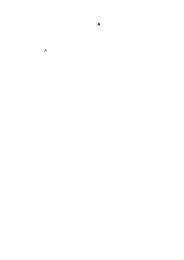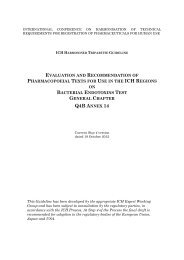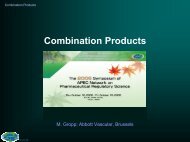4.05 Microbiological Examination of Non-sterile Products
4.05 Microbiological Examination of Non-sterile Products
4.05 Microbiological Examination of Non-sterile Products
- No tags were found...
Create successful ePaper yourself
Turn your PDF publications into a flip-book with our unique Google optimized e-Paper software.
to test the product.5 Testing <strong>of</strong> <strong>Products</strong>5-1 Amount used for the testUnless otherwise prescribed, use 10 g or 10 mL <strong>of</strong> the product to be examined taken withthe precautions referred to above. For fluids or solids in aerosol form, sample 10 containers.For transdermal patches, sample 10 patches.The amount to be tested may be reduced for active substances that will be formulated in thefollowing conditions: the amount per dosage unit (e.g. tablet, capsule, injection) is less than orequal to 1 mg or the amount per gram or milliliter (for preparations not presented in doseunits) is less than 1 mg. In these cases, the amount <strong>of</strong> sample to be tested is not less than theamount present in 10 dosage units or 10 g or 10 mL <strong>of</strong> the product.For materials used as active substances where sample quantity is limited or batch size isextremely small (i.e. less than 1000 mL or 1000 g), the amount tested shall be 1 per cent <strong>of</strong> thebatch unless a lesser amount is prescribed or justified and authorised.For products where the total number <strong>of</strong> entities in a batch is less than 200 (e.g. samplesused in clinical trials), the sample size may be reduced to 2 units, or 1 unit if the size is lessthan 100.Select the sample(s) at random from the bulk material or from the available containers <strong>of</strong>the preparation. To obtain the required quantity, mix the contents <strong>of</strong> a sufficient number <strong>of</strong>containers to provide the sample.5-2 <strong>Examination</strong> <strong>of</strong> the product5-2-1 Membrane filtrationUse a filtration apparatus designed to allow the transfer <strong>of</strong> the filter to the medium.Prepare the sample using a method that has been shown suitable as described in section 4and transfer the appropriate amount to each <strong>of</strong> 2 membrane filters and filter immediately.Wash each filter following the procedure shown to be suitable.For the determination <strong>of</strong> TAMC, transfer one <strong>of</strong> the membrane filters to the surface <strong>of</strong>casein soya bean digest agar. For the determination <strong>of</strong> TYMC, transfer the other membraneto the surface <strong>of</strong> Sabouraud-dextrose agar. Incubate the plate <strong>of</strong> casein soya bean digest agarat 30 – 35°C for 3 – 5 days and the plate <strong>of</strong> Sabouraud-dextrose agar at 20 – 25°C for 5 – 7days. Calculate the number <strong>of</strong> CFU per gram or per millilitre <strong>of</strong> product.When examining transdermal patches, filter 10 per cent <strong>of</strong> the volume <strong>of</strong> the preparationdescribed under 4-5-1 separately through each <strong>of</strong> 2 <strong>sterile</strong> filter membranes. Transfer onemembrane to casein soya bean digest agar for TAMC and the other membrane toSabouraud-dextrose agar for TYMC.5-2-2 Plate-count methods5-2-2-1 Pour-plate methodPrepare the sample using a method that has been shown to be suitable as described insection 4. Prepare for each medium at least 2 Petri dishes for each level <strong>of</strong> dilution. Incubatethe plates <strong>of</strong> casein soya bean digest agar at 30 – 35°C for 3 – 5 days and the plates <strong>of</strong>Sabouraud-dextrose agar at 20 – 25°C for 5 – 7 days. Select the plates corresponding to agiven dilution and showing the highest number <strong>of</strong> colonies less than 250 for TAMC and 50 forTYMC. Take the arithmetic mean per culture medium <strong>of</strong> the counts and calculate the number<strong>of</strong> CFU per gram or per millilitre <strong>of</strong> product.5-2-2-2 Surface-spread methodPrepare the sample using a method that has been shown to be suitable as described insection 4. Prepare at least 2 Petri dishes for each medium and each level <strong>of</strong> dilution. Forincubation and calculation <strong>of</strong> the number <strong>of</strong> CFU proceed as described for the pour-platemethod.5-2-3 Most-probable-number methodPrepare and dilute the sample using a method that has been shown to be suitable as6/29



